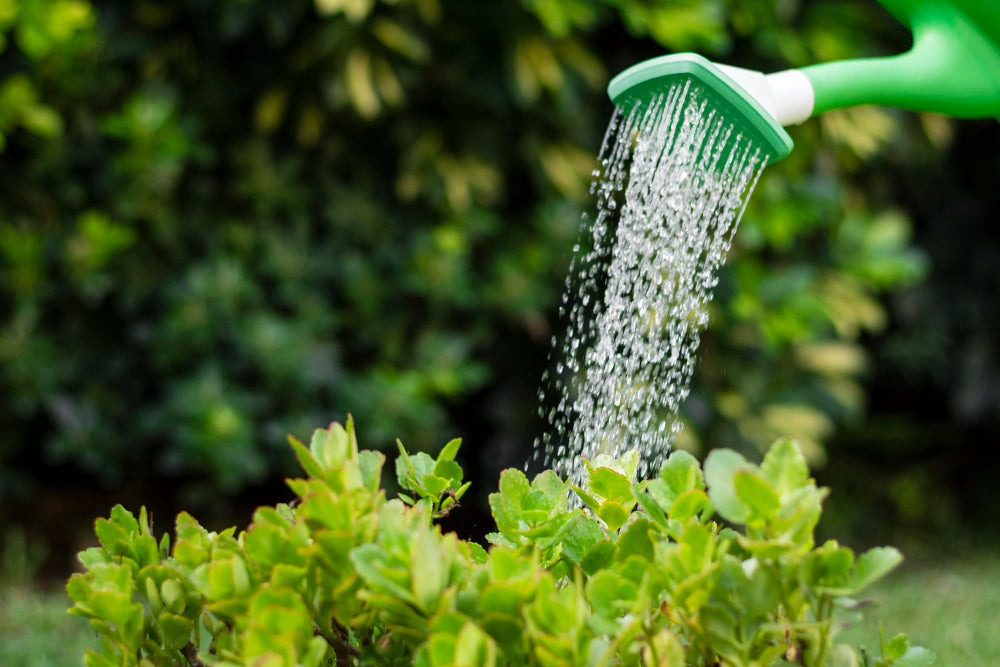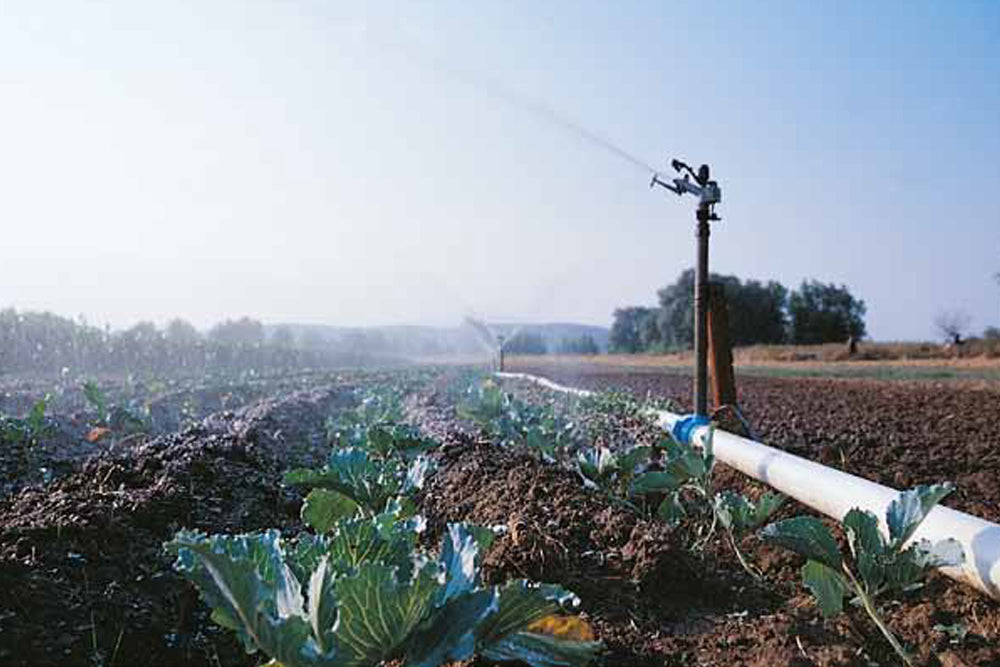Irrigation Glossary

There is a large range of technical terminology used in irrigation. The most commonly-used terms are defined here.
Aquifer
A water-bearing soil formation or group of formations having sufficient permeability to yield useable amounts of water to wells.
Axial flow pump
Pump design used for low-head, high flow conditions, also called a propeller pump. This design does not use centrifugal action (see Centrifugal Pump) to move water. Rather it uses the principle of a wedge. Water is physically forced through the pump by the rotating propeller.
Booster pump
A pump used for providing a medium to high discharge pressure. Usually used for pumps supplying sprinkler or micro-irrigation systems.
Bowl
The bowl, also called the pump housing, is the stationary part of the pump and often contains guide vanes to convert the rotation energy into pressure.
Bowl efficiency
Efficiency of the pump by itself (as opposed to combination of the pump driver and transmission system). It is difficult to determine bowl efficiency in the field. An estimation can be made by subtracting out other losses associated with the pumping station such as the power plant and transmission efficiencies.
Capacity
The flow rate of a pump. It is generally used when referring to the normal (or required design) flow rate of the pumping station.
Cavitation
The rapid formation and collapse of air bubbles in water as it moves through a pump. This results from too high a vacuum in the pump itself due to insufficient “net positive suction head.” Cavitation causes pitting of the impeller and pump housing and can greatly degrade pump performance.
Centrifugal pump
A pump in which water enters the center of a rotating impeller and is flung out radially, gaining energy in the process. This is also a term commonly used for a specific type of pump where the impeller is enclosed in a volute casing. A volute casing is a type of casing where the area of water flow increases uniformly
towards the pump discharge. The increase in flow area converts the velocity achieved through centrifugal action into pressure.
Check valve
A valve installed in a pipeline that automatically closes and stops water from flowing backwards when a pump is shut off. This is also called a non return valve
Chemigation
The application of pesticides or system maintenance products through an irrigation system.
Chlorination
Periodic injection of chlorine compounds into wells to prevent the growth of bacteria and slimes. Also used when referring to injection into irrigation systems, most often micro-irrigation systems.
Corrosion
Deterioration and destruction of metal by chemical and/or galvanic reactions. Chemical corrosion dissolves the metal, which is then carried away by the water. Chemical corrosion can allow sand to enter the well. Galvanic corrosion is caused by electrolytic cells forming between dissimilar metals or surfaces.
CO2 footprints
A carbon footprint has historically been defined as the total set of greenhouse gas (GHG) emissions caused by an organisation, event, product or person. This is typically calculated as a carbon dioxide equivalent (CO2e), using the relevant 100-year global warming potential. For simplicity of reporting, it is often expressed in terms of the amount of carbon dioxide.
Daily crop water use (evapotranspiration – ET)
This is the net amount of water extracted from the soil daily by the crop and surface evaporation from the soil.
Data bus
This is also called a fieldbus and refers to the family of industrial computer network protocols used for real-time distributed control. An automated industrial system (e.g. a manufacturing assembly line) usually needs an organised hierarchy of controller systems to function. In this hierarchy there is usually a Human Machine Interface (HMI) at the top, where an operator can monitor or operate the system. This is typically linked to a middle layer of programmable logic controllers (PLC) via Ether glossary net. At the bottom of the control chain is the fieldbus that links the PLCs to the sensors and actuators (for example, the motors, pumps, and valves in the field) that actually do the work.
Deep well pumps
Also called groundwater pumps, these are typically multistage pumps of either the submersible pump type or the vertical turbine type. Bowl and impellers are often identical, but the submersible pump has a submersible motor, while the vertical turbine has a dry motor above the water.
Development of well
The process of removing the finer material from the aquifer or gravel pack surrounding a new well, which may include drilling mud forced into the formation during well construction. If performed after the well has been in service for some time it is referred to as “re-developing” a well.
Discharge head
The pressure at the discharge flange of a pump.
Distribution uniformity (DU)
A measure of how evenly water soaks into a field during an irrigation. It is usually a percentage between 0 and 100; the higher the number the better. A DU of 100% is theoretically possible but practically impossible to achieve. It is the upper limit of irrigation efficiency if the whole field is sufficiently irrigated.
Drawdown
The difference in elevation between static and dynamic (pumping) water levels in a well, usually following a specified operating time.
Duty point
The duty point of a pump is the flow and head produced when it is pumping at maximum efficiency.
Effective root zone
The depth of soil in which you are actively managing the crop (fertiliser levels, tilth, soil moisture, etc.).
Elevation lift
The term used when a pump transfers water from one elevation level to another elevation level.
Enclosure Class
Enclosure Class is used to classify electrical equipment and states under which condition the equipment may be used (indoor, outdoor, submerged, and so on).
Evapotranspiration (ET)
See “daily crop water use”
Field capacity
The amount of water the soil will hold.
Fertigation
The application of fertiliser and/or soil additions with water from the irrigation system.
Flow meter
Any measuring device used to measure fluid flow rates in a pipe or open channel. The flow meter may measure instantaneous flow rates or total fluid volumes over a period of time.
Freeboard
Distance from the top of the flowing water to the top of the channel banks.
Friction loss
Water pressure lost as a result of contact between moving water and the enclosure that it is moving in (either a pipeline or open channel).
Fuse
An electrical device that protects the electrical system from overload. A fuse is typically fast-reacting, and disconnects the electrical current when a maximum value is exceeded.
Gravel pack
A thin layer of various sizes of gravel placed between the well casing and the well itself. Gravel packs are designed to prevent soil particles from entering the well casing.
Head (meters of head)
A practical measure for pressure as it can be used directly in al metric formulas and calculations.
Horsepower (hp)
Horsepower is a rate of doing work - how far can a mass be moved in a period of time. One hp is equal to 0,746 kW.
Impeller
The impeller is the rotating component of the pump and is contained within the pump bowl (or pump volute). Impellers may be configured as open, closed, or semi-open. They are usually made of bronze, cast iron, plastic, or cast iron coated with porcelain enamel. The impeller transfers energy developed by the pump driver to the water as water flows through the pump bowl.
Impeller trim
The specific diameter of the impeller used in a pump. Impellers are cast at the maximum diameter but may be “trimmed” to better match the required operating condition(s).
Irrigation efficiency (IE)
A measure of how much water that is pumped and applied to a field is beneficially used. (Beneficial uses include crop water use and leaching for salt control.) One must know the physical and time boundaries of the measurement for it to be meaningful. The IE for a single irrigation on a field may be different than the average IE for all irrigations on that field for a season. It may be different than the IE for the entire farm for the season. It is usually expressed as a percentage between 0 and 100. An IE of 100% is not theoretically possible due to immediate evaporation of water during irrigation.
Irrigation scheduling
The purpose of irrigation scheduling is to determine the exact amount of water to apply to the field and the exact timing for application. The amount of water applied is determined by using a criterion to determine irrigation need and a strategy to describe how much water to apply in any situation.
Manometer
A portable device using what is known as velocity head (the energy of the moving water) to measure water flow rates in pipelines. These are commonly used during pump efficiency tests due to the ease of installation and removal. However, they are large and require careful handling and are not generally recommended for use by pump owners.
Mixed flow pump
Mixed flow pumps combine the principles of radial and axial flow impeller designs.
Multi-stage pump
A pump having more than one impeller/bowl assembly. Commonly used when referring to turbine pumps and submersible pumps.
Net positive suction head (NPSH)
A design requirement dependent on the individual pump. The required NPSH must be available at the pump inlet to prevent cavitation .Net water needed versus gross water applied Net water is what you need to replace in the field. Gross water is how much you have to pump in order to accomplish this goal.
Operating condition
The combination of flow and pressure (total dynamic head) developed by the pump. A pump can operate at a number of operating conditions defined by its pump performance curve.
Overload relay
A device that protects the equipment, typically an electric motor, from long term overload. An overload relay will allow short term overload without breaking the circuit.
Parallel pumps
Two or more pumps (many times of different sizes for flexibility) discharging into a common pipeline to increase the flow rate at a given pressure in the pipeline.
Programmable Logic Controller (PLC)
A PLC is used for the automation of electromechanical processes, such as control of machinery on factory assembly lines, control of pumps and valves in processing plants and many other similar types of systems. The PLC is designed for flexible multiple inputs and output arrangements, extended temperature ranges, immunity to electrical noise, and resistance to vibration and impact.
Pump
A mechanical device that converts mechanical energy (usually a rotating shaft or reciprocating rod) into hydraulic energy (flowing water for example).
Pump capacity
The flow rate through a pump in cubic meters per hour (m3/h)
Pump efficiency
The relation between the power produced by the pump (product of flow and head) and the motor horsepower needed to drive the pump. Pump efficiency should be minimum 70%. The pump efficiency can be read from the manufacturer’s pump curves.
Pump housing
The pump housing, also called the bowl, is the stationary part of the pump, and often contains guide vanes to convert the rotation energy into pressure.
Pump and motor efficiency
The relation between the power produced by the pump (product of flow and head) and the power absorbed by the motor, in kW. Pump and Motor Efficiency can be measured.
Pump performance curve
A set of measurements, usually in graphical form, available from the pump manufacturer showing the relationship between total head, horsepower requirements, and net positive suction head requirements at any given flow rate for a pump.
Pumping lift
The distance from the center line of the discharge pipe at the pump head to the water level in the pumping well.
Pumping water level
The water level in a well after the pump while pumping is in progress. Typically a pump tester will measure this level after 10 to 60 minutes of pumping. This may or may not represent pumping water levels hours or days later.
Radial flow pumps
Radial flow pumps have impeller designs capable of generating a high pressure.
Revolutions per minute (RPM)
The rotating speed of the shaft of a pump or the driver (motor).
Sand separator
A device installed on the pump intake pipe in deep-well turbine pumps to remove sand from the water before it can enter the pump. They may also be installed on the pump outlet works and be used to remove sand in water before it enters water distribution systems (municipal, industrial, or irrigation).
SCADA
The term SCADA (Supervisory Control and Data Acquisition) usually refers to centralised systems that monitor and control entire sites, or complexes of systems that can be spread out over large areas (anything from an irrigation system to a country). Most control actions are performed automatically by Dedicated Controllers or by PLCs (Programmable Logic Controller).
Series pumps
Two or more pumps installed so that one pump discharges into the intake of another pump, increasing pressure at a given flow rate. The total head developed by the second pump is added to the total head of the first pump. The most common configuration is a well pump discharging into a booster pump. Note also that a “multi-stage” turbine pump is actually a pump connected in series.
Single stage pump
A single stage pump has only the pump housing or bowl with one impeller.
Soil moisture depletion (SMD)
The net amount of water that you need to replace in the root zone of the crop.
Soil probe
A long piece of ca. 10 mm steel bar, usually tipped by a ball bearing, with a handle. The probe is pressed into wetted soil to judge how deep water has penetrated. It can be used during an irrigation to indicate when enough water has soaked into the ground. It can also be used to judge the uniformity of an irrigation. If 2-3 days after an irrigation the probe can be pushed into the soil to a depth of ca. 1.2 m at the top of a furrow, and only to 0.6feet at the bottom of the same furrow, this is an indication of poor distribution uniformity.
Stage
One impeller/bowl assembly of a multi-stage pump. Pumps can be termed as “single-stage” or “multi-stage” pumps.
Static water level
The depth of the water level in a well when unaffected by the pumping of that well.
Suction lift (suction head)
Distance from the water surface to the pump intake when the pump is located above the water surface.
Suction water level
The water level from where the pump must pump the water.
Submersible pump
A type of deep well pump that utilises a waterproof electric motor connected directly to the pump, both installed in the well below the pumping water level.
System curve
The system curve of a pumping system is a term for the friction in the system. The friction comes from pipes, valves, elbows, tee’s, and the like, and is often constant. Clogging of the system, or if a valve’s setting is changed are examples of things that will change the system curve. By definition the system curve always
goes through the duty point of the pump.
Tailwater
Tailwater refers to waters located immediately downstream from a hydraulic structure, such as a dam, bridge or culvert.
Time-of-use rates (TOU)
Electric power rate schedules whereby lower costs are offered for power used in the “off-peak” (and sometimes during the “shoulder” or “mid-peak”) period and higher rates are charged for power used during “on-peak” periods. The term “onpeak” refers to times when power use is the highest for a utility. Conversely, offpeak refers to that time when power use is lowest.
Totaliser
A type of flow meter, or a part of a flow meter, that provides a measure of total water volume flowing past a point over time.
Turbine pump
This pump operates on the principle of centrifugal action. As water enters the impeller it is flung outward, gaining energy, through the rotation of the impeller. Many times, multiple pump assemblies (pump bowl and impeller) are stacked on top of each other and the water is directed by the pump bowl upwards to the next impeller/bowl assembly.
Uniformity
Also called Distribution Uniformity. Uniformity is in percent, and the number indicates how even a given amount of water is distributed over a given area. The higher the number, the better is the uniformity.
Variable frequency (speed) drive (VFD)
A solid-state electrical device used to change the frequency of AC electric energy supplied to an electric motor. Varying the frequency of the AC current will vary the speed of the motor, allowing the electric motor to be throttled like an internal combustion engine. VFDs are used in situations requiring many different operating conditions on a regular basis.
Vertical turbine pump (VTP)
A turbine pump installed inside a well casing below the pumping water level in the well. The motor is not installed in the water.
Viscosity
The viscosity of a fluid says something about how thick or thin it is, and how easy it will flow. A thick fluid, like syrup, has a high viscosity, while water has a low viscosity.
Water hammer
Water hammer can occur when water is flowing in a pipe and a valve is closed too quickly, causing possible damage to the pipes.
Well casing
Pipe (usually some type of metal but may also be plastic) used as the lining for a well. A layer of rock (termed the “gravel pack”) is usually placed between the well casing and the aquifer to help prevent soil particles from entering the well. The casing will have small openings (called perforations or slots) at levels where water-bearing soil formations are thought to be.
Well efficiency
The drawdown outside the well casing divided by the drawdown inside the well (the higher the number the better).


